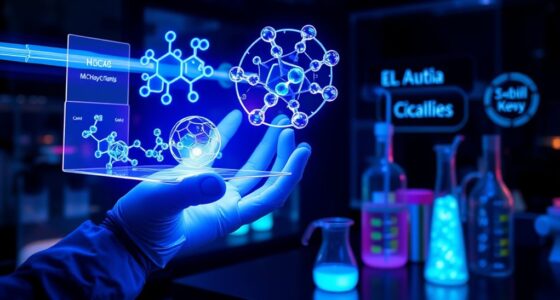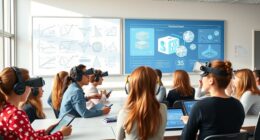Imagine a scenario where every student receives personalized education tailored to their specific needs. With the help of AI technology, this dream is becoming a reality.
We have witnessed firsthand how AI revolutionizes education, empowering students to reach their full potential. Through intelligent algorithms and adaptive learning platforms, AI transforms the traditional classroom, making learning a liberating experience for all.
In this article, we explore the remarkable advancements and future implications of unleashing the power of AI in personalized education.
Key Takeaways
- AI in personalized education provides data and insights for tailored instruction.
- AI-powered tutoring offers real-time feedback and guidance for individualized learning.
- AI technology enhances student engagement by delivering personalized content and integrating gamification elements.
- The future of AI in education holds promising potential for transforming the traditional education system, expanding access to quality education, and unlocking students’ full potential.
The Role of AI in Personalized Learning
AI plays a crucial role in personalizing learning experiences by providing us with a vast amount of data and insights. Through AI-driven adaptive learning, education can be tailored to individual needs and preferences, liberating learners from the constraints of traditional one-size-fits-all approaches.

AI-powered tutoring takes this personalization even further by offering real-time feedback and guidance, helping learners navigate complex subjects and master difficult concepts. With AI, students can access personalized recommendations, adaptive assessments, and targeted interventions that address their unique learning challenges. This empowers learners to take ownership of their education, fostering a sense of autonomy and independence.
AI’s ability to analyze and interpret data also enables educators to gain valuable insights into student progress and performance, allowing for more targeted instruction and support. Ultimately, AI in personalized learning revolutionizes education, offering a liberating and empowering experience for learners.
Advantages of AI in Education
One of the key advantages of implementing AI in education is the ability to provide personalized learning experiences. AI benefits in education are numerous and impactful. Here are three ways AI is revolutionizing the educational landscape:
-
Adaptive Learning: AI algorithms can analyze student data and tailor educational content to the individual’s specific needs and learning style. This enables students to learn at their own pace and focus on areas where they need more support.

-
Intelligent Tutoring: AI-powered virtual tutors can provide personalized feedback and guidance to students, helping them understand concepts more effectively. These virtual tutors can adapt their teaching methods based on the student’s progress and provide targeted assistance.
-
Data-driven Insights: AI tools can analyze vast amounts of educational data to identify trends, patterns, and areas for improvement. By leveraging this data, educators can make informed decisions and create more effective teaching strategies.
The impact of AI in education is undeniable. It empowers students to take control of their learning journey and enables educators to provide personalized support, ultimately leading to improved educational outcomes.
Applications of AI in Tailored Instruction
As we delve into the applications of AI in tailored instruction, we continue to harness the power of personalized learning experiences enabled by AI in education.

Two key applications in this realm are AI-driven adaptive learning and AI-powered tutoring. AI-driven adaptive learning leverages machine learning algorithms to analyze student data and provide personalized learning paths. It adapts to each student’s unique needs, abilities, and learning pace. This ensures that students receive targeted instruction, allowing them to progress at their own pace and focus on areas where they need more support.
On the other hand, AI-powered tutoring utilizes intelligent tutoring systems to provide personalized guidance and support to students. These systems can simulate one-on-one tutoring experiences, offering immediate feedback, answering questions, and providing personalized recommendations.
The integration of AI in tailored instruction opens up new possibilities for individualized learning, empowering students to reach their full potential.
Enhancing Student Engagement With AI
We can enhance student engagement by leveraging the power of AI in personalized education. AI technology allows for interactive learning experiences that adapt to each student’s unique needs and preferences. Here are three ways AI enhances student engagement:

-
Personalized content: AI algorithms analyze student data to deliver customized learning materials and activities. This tailored approach keeps students actively engaged by presenting them with content that aligns with their interests and learning styles.
-
Real-time feedback: AI-powered platforms provide immediate feedback to students, allowing them to track their progress and make adjustments accordingly. This instant feedback motivates students to stay engaged and strive for improvement.
-
Gamification elements: AI integrates gamification elements into educational experiences, making learning more fun and interactive. By incorporating game-like features such as rewards, badges, and leaderboards, AI technology encourages students to actively participate and stay engaged throughout their educational journey.
Future Implications of AI in Education
Moving forward, let’s delve into the future implications of integrating AI into education and further explore its potential for transforming the learning experience.

The incorporation of AI in education brings with it ethical considerations that must be carefully addressed. One concern is the potential for bias in AI algorithms, which could perpetuate existing inequalities in education. Another challenge is the need for transparency and accountability in AI systems, ensuring that students and educators understand how decisions are made.
Furthermore, limitations such as the inability of AI to fully replicate human empathy and creativity should be acknowledged. Despite these challenges and limitations, the future of AI in education is promising.
With proper regulation and thoughtful implementation, AI has the potential to revolutionize education, providing personalized and adaptive learning experiences that cater to the unique needs of each student.
Frequently Asked Questions
How Does AI in Personalized Learning Impact Student Motivation and Self-Confidence?
AI in personalized learning boosts student motivation and self-confidence by tailoring content to individual needs and preferences. It enhances engagement by providing real-time feedback and measuring effectiveness, empowering students to take ownership of their education.

Can AI in Education Help Identify and Address Specific Learning Disabilities or Challenges?
AI in education can revolutionize how we identify learning disabilities and address individual challenges. By harnessing its power, we can unlock personalized solutions that liberate students from barriers to their education.
What Are Some Potential Ethical Concerns Surrounding the Use of AI in Personalized Education?
Privacy concerns and algorithm bias are potential ethical concerns surrounding the use of AI in personalized education. We must ensure that student data is protected and that algorithms do not perpetuate bias or discrimination.
How Does AI in TAIlored Instruction Accommodate Different Learning Styles and Preferences?
AI in tailored instruction adapts content and provides individualized feedback, catering to various learning styles and preferences. With its power and adaptability, AI revolutionizes education, liberating learners to explore their unique potential.
What Are the Potential Limitations or Drawbacks of Implementing AI in Education?
The potential limitations and drawbacks of implementing AI in education include concerns over privacy, lack of human interaction, and potential for bias. However, with careful planning and oversight, these challenges can be addressed and AI can greatly enhance personalized education.

Conclusion
In conclusion, AI has the potential to revolutionize personalized education by providing tailored instruction, enhancing student engagement, and improving learning outcomes.
While some may argue that AI could replace human teachers, it’s important to remember that technology is meant to complement and support educators, not replace them.
By harnessing the power of AI in education, we can create a more efficient and effective learning experience for all students, while still valuing the expertise and guidance of teachers.










